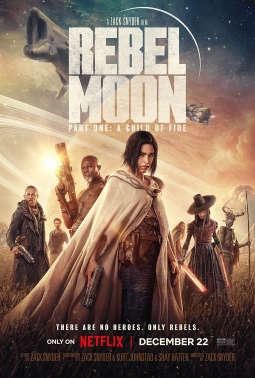Zack Snyder’s latest venture, “Rebel Moon – Part One: A Child of Fire,” marks a significant addition to the sci-fi genre. A lavish, four-and-a-half-hour interplanetary action spectacle released in two parts, the film has garnered attention and anticipation, especially following Snyder’s success with “Zack Snyder’s Justice League.”
The narrative revolves around a colony on the edge of the galaxy facing a dire threat from the armies of the tyrannical Regent Balisarius. To counter this menace, a young woman with a mysterious past, Kora, is dispatched to gather warriors from neighboring planets for a rebellion.
While the film is visually impressive, boasting CGI sprawl backed by a substantial budget, it does not escape criticism for its heavily derivative nature. Described as a gloss on the 1977 “Star Wars,” “Rebel Moon” blends elements from various iconic franchises, including “Guardians of the Galaxy,” “The Lord of the Rings,” and “Black Panther.” This approach, while providing a sense of familiarity, raises questions about the film’s originality.
Snyder, known for his distinctive visual style, stages the movie on an impressively lavish scale. The episodic structure, introducing new planets and characters, contributes to the film’s watchability, but it also leads to a somewhat disjointed narrative.
Despite its derivative nature, “Rebel Moon” remains eminently watchable, with Sofia Boutella’s portrayal of Kora standing out with dour ferocity. The film’s episodic journey, featuring colorful characters and slow-motion combat sequences, offers moments of entertainment.
Ultimately, “Rebel Moon” may cater more to Snyder cultists, given its unabashed borrowing from familiar tropes. While lacking the cool factor of originality, the film’s star power and visual grandeur ensure an engaging cinematic experience for those drawn to Snyder’s signature style.
another person says
“Rebel Moon – Part One: A Child of Fire” unfolds as a grand interplanetary saga set on the edge of the galaxy, where a colony faces the looming threat of the tyrannical Regent Balisarius. Directed by Zack Snyder, this sci-fi epic takes audiences on a journey filled with rebellion, mystique, and a quest for warriors from neighboring planets.
The story centers around Kora, a young woman with a mysterious past, who is tasked with seeking out warriors to help the colony stand against Balisarius’ armies. The narrative kicks off on Veldt, a moon reminiscent of a fusion of Jupiter and Saturn, where Kora is part of a community of medieval farmers. The world-building introduces a vivid backdrop, with Kora’s home facing invasion by Motherworld’s brigade led by the sinister Atticus Noble.
As Kora embarks on her quest, the film adopts an episodic structure, showcasing diverse planets and characters. The recruitment of a fellowship of rebel fighters becomes the central focus, with each planet bringing new challenges and allies. The narrative is propelled by Kora’s determination and the need to form a united front against the oppressive regime.
Snyder, who shot the film himself, displays his penchant for visual spectacle, delivering CGI-laden landscapes and epic combat sequences. The movie’s impressive scale is complemented by the diverse cast, each actor contributing to the unfolding saga.
While “Rebel Moon” weaves a narrative that borrows elements from classic sci-fi tropes, it manages to create a sense of excitement and engagement. The episodic nature of the story, while contributing to some pacing challenges, allows for the exploration of different facets of the Rebel Moon universe.
As the film sets the stage for “Rebel Moon – Part Two: The Scargiver,” scheduled for release in April 2024, audiences are left anticipating the continuation of this expansive interplanetary saga. “Rebel Moon” may draw inspiration from familiar sources, but its commitment to originality within the sci-fi genre adds a layer of intrigue to the unfolding story.
